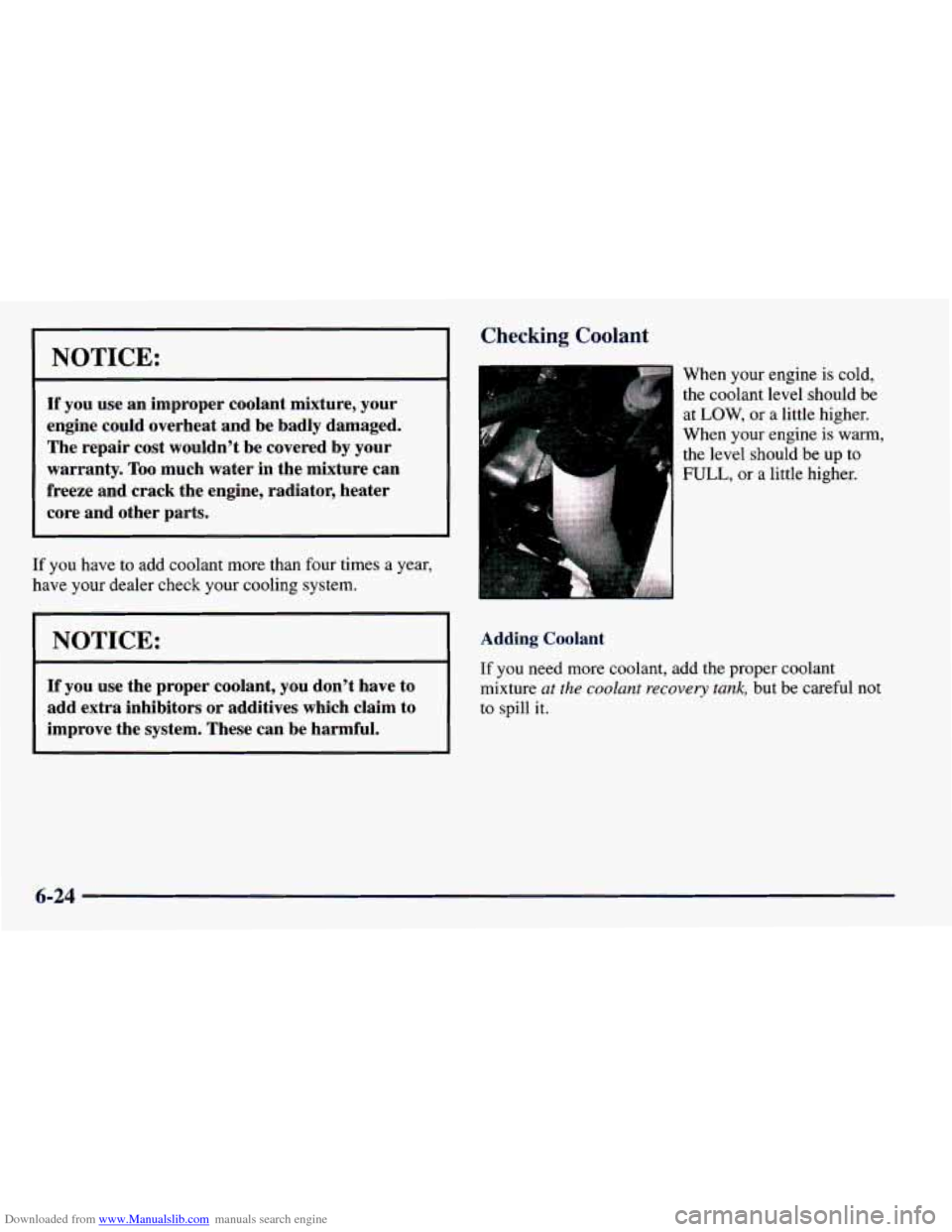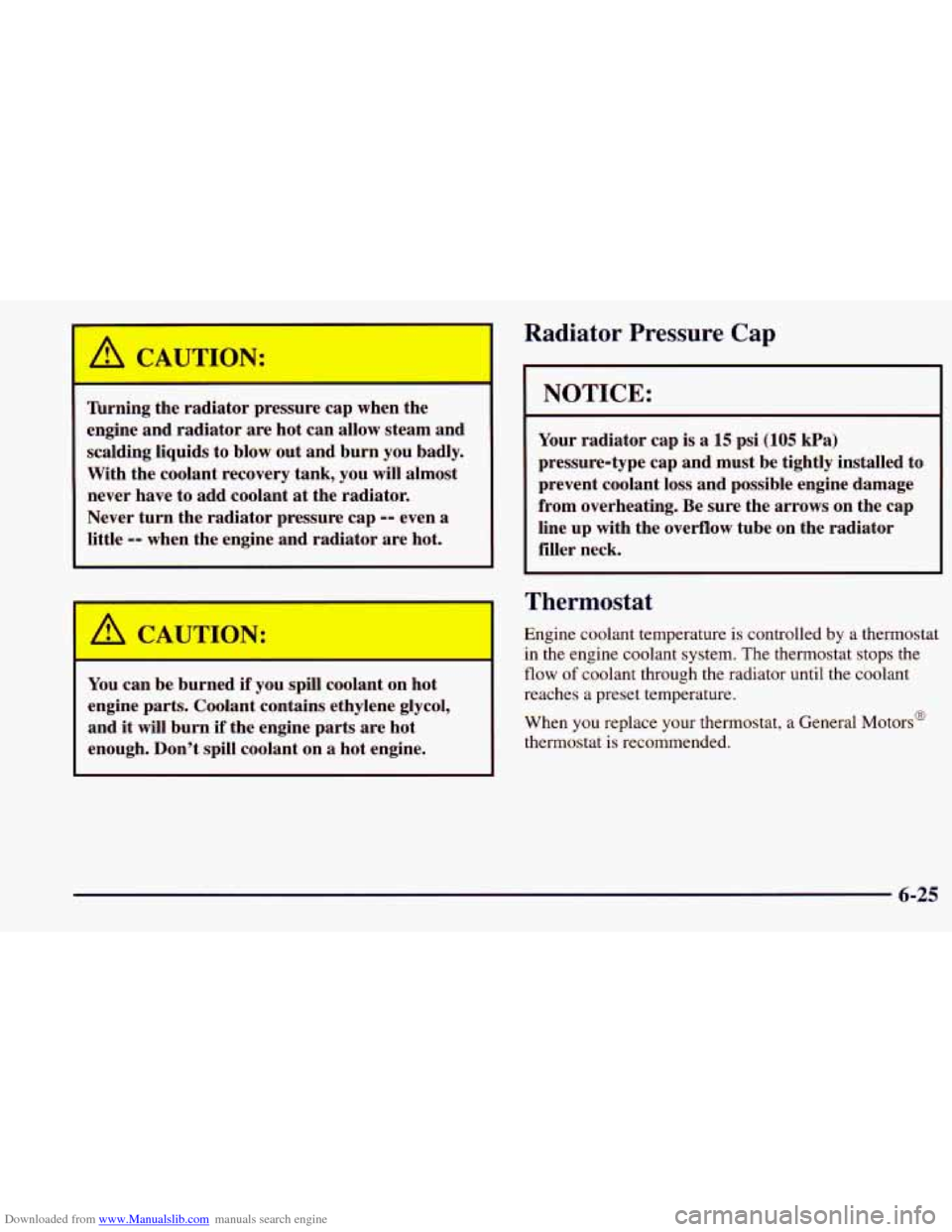1998 CHEVROLET PRIZM engine overheat
[x] Cancel search: engine overheatPage 250 of 364

Downloaded from www.Manualslib.com manuals search engine NOTICE:
If you use an improper coolant mixture, your
engine could overheat and be badly damaged.
The repair cost wouldn’t be covered
by your
warranty. Too much water in the mixture can
freeze and crack the engine, radiator, heater
core and other parts.
If you have to add coolant more than four times a year,
lave
your dealer check your cooling system.
I NOTICE:
If you use the proper coolant, you don’t have to
add extra inhibitors or additives which claim to
improve the system. These can be harmful.
Checking Coolant
When your engine is cold,
the coolant level should be
at
LOW, or a little higher.
When your engine is warm,
the level should be up to
FULL, or a little higher.
Adding Coolant
If you need more coolant, add the proper coolant
mixture
at the coolant recovery tank, but be careful not
to spill it.
6-24
Page 251 of 364

Downloaded from www.Manualslib.com manuals search engine Radiator Pressure Cap
Wrning the radiator pressure cap when the
engine and radiator are hot can allow steam and
scalding liquids to blow out and burn you badly.
With the coolant recovery tank, you will almost
never have to add coolant
at the radiator.
Never turn the radiator pressure cap
-- even a
little -- when the engine and radiator are hot.
A CAUTION:
d if you spill coolant on hot
engine parts. Coolant contains ethylene glycol,
and it will burn if the engine parts are hot
enough. Don’t spill coolant on
a hot engine.
I NOTICE:
Your radiator cap is a 15 psi (105 kPa)
pressure-type cap and must be tightly installed to
prevent coolant loss and possible engine damage
from overheating. Be sure the arrows on the cap
line up with the overflow tube on the radiator
filler neck.
Thermostat
Engine coolant temperature is controlled by a thermostat
in the engine coolant system. The thermostat stops the
flow of coolant through the radiator until the coolant
reaches a preset temperature.
When you replace your thermostat, a General Motors@
thermostat is recommended.
6-25
Page 263 of 364

Downloaded from www.Manualslib.com manuals search engine To replace the rear combination lamps:
1. Open the trunk.
2. Remove the three plastic screws.
3. Pull back the access panel.
4. Turn the bulb socket to the left and pull it out.
5. To remove the tail/stop or turn signal lamps, turn the
bulb socket in, to remove it from the housing. Then
push in and turn the bulb to the left.
6. To remove the sidemarker socket, turn it to the left to
remove the housing. Then pull the bulb straight out from the socket.
7. Reverse the steps to install a new bulb.
Tires
Your new vehicle comes with high-quality tires made by
a leading tire manufacturer.
If you ever have questions
about your tire warranty and where to obtain service, see
your Chevrolet Warranty booklet for details.
I - xlJ _____ nk-led ar-- imprc, xly used ti- ,s
are dangerous.
a
a
a
a
Overloading your tires can cause
overheating
as a result of too much friction.
You could have an air-out and
a serious
accident. See “Loading Your Vehicle” in
the Index.
Underinflated tires pose the same danger
as
overloaded tires. The resulting accident
could cause serious injury. Check all tires
frequently to maintain the recommended
pressure. Tire pressure should be checked
when your tires are cold.
Overinflated
tires are more likely to be
cut, punctured or broken by
a sudden
impact
-- such as when you hit a pothole.
Keep tires
at the recommended pressure.
Worn, old tires can cause accidents.
If your
tread
is badly worn, or if your tires have
been damaged, replace them.
6-37
Page 280 of 364

Downloaded from www.Manualslib.com manuals search engine Headlamps Wiring Fuses and Circuit Breakers
The
headlamp wiring is protected by a circuit breaker.
An electrical overload will cause the lamps to go on and
off, or in some cases to remain
off. If this happens, have
your headlamp wiring checked right away.
Windshield Wipers Fuses
The windshield wiper motor is protected by a circuit
breaker and a fuse. If the motor overheats due to heavy
snow, etc., the wiper will stop until the motor cools. If
the overload is caused by some electrical problem, and
not snow, etc., be sure to get it fixed.
Power Windows and Other Power Options
Circuit breakers protect the power windows and other
power accessories. When the current load is too heavy,
the circuit breaker opens and closes, protecting the
circuit until the problem is fixed or goes away. The wiring circuits in your vehicle are protected from
short circuits by fuses, circuit breakers and fusible
thermal links in
the wiring itself. This greatly reduces
the chance of fires caused by electrical problems.
Look at the silver-colored band inside the fuse. If the
band is broken or melted, replace the fuse. Be sure you
replace
a bad fuse with a new one of the correct size.
If you ever have a problem on the road and don’t
have a
spare fuse, you can borrow one. Just pick some feature
of your vehicle that you can get along without -- like the
radio or air conditioner
-- and use its fuse, if it is of the
value you need. Replace it as soon as you can.
Before replacing
a fuse, turn every electrical switch off.
6-54
Page 351 of 364

Downloaded from www.Manualslib.com manuals search engine Cooling System ................................ 5-16
Courtesy Transportation
....................... 8.6. 8.8
Cruise Control ................................. 2-30
Ending Out
of ................................ 2-32
Erasing Speed Memory
........................ 2-32
Increasing Speed While Using
................... 2-31
Passing Another Vehicle While Using
............. 2-3 1
Reducing Speed While Using ................... 2-31
Resuming
a Set Speed ......................... 2-31
Setting
..................................... 2-30
Using On Hills
............................... 2-32
CruiseLight
................................... 2-53
Cupholder
..................................... 2-37
Customer Assistance for Text Telephone Users
......... 8-4
Customer Assistance Information
................... 8- 1
Customer Satisfaction Procedure .................... 8-2
Damage Finish
...................................... 6-50
SheetMetal
................................. 6-50
Daytime Running Lamps
......................... 2-33
Dead Battery ................................... 5-3
Defects, Reporting Safety ................... 8-10, 8-11
Defensive Driving
............................... 4-2
Defogger, Rear Window
.......................... 3-5
Defogging
..................................... 3-5
Defrosting
..................................... 3-5
Dimensions, Vehicle
............................ 6-60
DomeLamps
.................................. 2-34
Door Locks
....................................... 2-4
Storage Compartment
......................... 2-37
Drive Position, Automatic Transaxle
................ 2- 16 Driver Position
................................. 1 . 13
Driving
City
........................................ 4-19
Defensive
.................................... 4-2
Drunken
..................................... 4-3
Freeway
.................................... 4-20
InaBlizzard
................................. 4-26
In Foreign Countries ........................... 6-5
IntheRain
.................................. 4-16
Night
...................................... 4-15
On Grades While Towing a Trailer
............... 4-36
On Hill and Mountain Roads
.................... 4-22
OnSnowandlce
............................. 4-25
Through Water ............................... 4-18
Wet Roads
.................................. 4-16
Winter
...................................... 4-24
WithaTrailer
................................ 4-34
Drunken Driving
................................ 4-3
Electrical Equipment, Adding
.......... 2-14,3-15, 6-53
Electrical System
............................... 6-53
Engine
....................................... 6-11
Compartment
Fuse Blocks ............ 6-56,6-57, 6-58
Coolant
..................................... 6-23
Coolant Level Check
.......................... 7-37
Coolant Temperature Gage
..................... 2-49
Exhaust
.................. 2-9,2-24,4-27,4-33, 7-42
Identification
................................ 6-53
OilLevelCheck
.............................. 7-37
Overheating
................................. 5-14
Running While Parked ......................... 2-24
StartingYour ................................ 2-13
Engine Cooling When Trailer Towing
............... 4-37
Page 354 of 364

Downloaded from www.Manualslib.com manuals search engine Locks ......................................... 2-4
Cylinder
.................................... 7-39
Door ........................................ 2-4
Ignition Transaxle Lock Check .................. 7-40
Key Lock Cylinder Service
..................... 7-39
Rear Door Security
............................. 2-5
Remote Trunk Release
......................... 2-10
Trunk Release ................................ 2- 10
Low Gear, Automatic Transaxle ................... 2- 17
Lubricants and Fluids
............................ 7-44
Lubrication Service, Body ........................ 7-39
PowerDoor
.................................. 2-5
Maintenance. Normal Replacement
parts ........... 6-60
Maintenance Record
............................ 7 -46
Long TripMighway Definition
................... 7-6
Long Trip/Highway Intervals
..................... 7-7
Owner Checks and Services
..................... 7-37
Periodic Maintenance Inspections
................ 7-42
Recommended Fluids and Lubricants
............. 7-44
Scheduled Maintenance Services
.................. 7-4
Short Trip/City Definition
....................... 7-5
Short TripKity Intervals
........................ 7-5
Maintenance. Underbody
......................... 6-5 1
Making Turns While Driving a Trailer .............. 4-35
Malfunction Indicator Lamp
...................... 2-49
Manual Transaxle
.......................... 2- 13, 2- 18
Fluid ....................................... 6-21
............................ I Maintenance Schedule 7-1
ManualFrontSeat ..................,............ l-2
ManualMirror ................................. 2-35
Operation
................................... 2-18 Shiftspeeds
................................. 2-19 Shifting ..................................... 2-18
Starting
Your Engine .......................... 2-13
Manual Transaxle Fluid
.......................... 6-21
Methanol ...................................... 6-5
Convex Outside .............................. 2-36
Inside Daymight Rearview
..................... 2-35
Power Remote Control ......................... 2-36
Visor Vanity
................................. 2-38
Mirrors ....................................... 2-35
Manual ..................................... 2-35
MMT
......................................... 6-4
MountainRoads
................................ 4-22
Neutral Automatic Transaxle
.......................... 2-16
Manual Transaxle
............................. 2-19
New Vehicle Break-In
........................... 2-11
Nightvision
................................... 4-15
Normal Maintenance Replacement
Parts ............. 6-60
Odometer
.................................... 2-44
Odometer. Trip
................................. 2-44
Off-Road Recovery
............................. 4-12
Overdrive, Automatic Transaxle
................... 2-17
OverdriveOffLight
............................. 2-53
Overheating Engine
............................. 5-14
Owner Checks and Services
....................... 7-37
Owner Publications, Ordering
................ 8- 11, 8- 12
Oil. Engine
.................................... 6-12
9-6